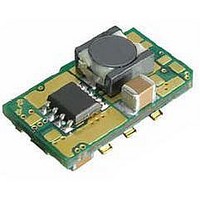YM05S05 POWER ONE, YM05S05 Datasheet - Page 7

YM05S05
Manufacturer Part Number
YM05S05
Description
Module DC-DC 1-OUT 0.7525V to 3.63V 5A 5-Pin SMD
Manufacturer
POWER ONE
Type
Step Downr
Datasheet
1.YM05S05-G.pdf
(24 pages)
Specifications of YM05S05
Package
5SMD
Output Current
5 A
Output Voltage
0.7525 to 3.63 V
Input Voltage
5 V
Number Of Outputs
1
Product
Non-Isolated / POL
Input Voltage Range
4.5 V to 5.5 V
Input Voltage (nominal)
5 V
Output Current (channel 1)
5 A
Package / Case Size
DIP
Output Type
Regulated
Package / Case
DIP
Lead Free Status / Rohs Status
Lead free / RoHS Compliant
Available stocks
Company
Part Number
Manufacturer
Quantity
Price
Company:
Part Number:
YM05S05
Manufacturer:
PERICOM
Quantity:
201
Part Number:
YM05S05
Manufacturer:
POWER-ONE
Quantity:
20 000
Company:
Part Number:
YM05S05-G
Manufacturer:
BELPOWER
Quantity:
200
Part Number:
YM05S05-G
Manufacturer:
BEL
Quantity:
20 000
The figures are numbered as Fig. x.y, where x
indicates the different output voltages, and y
associates with specific plots (y = 1 for the vertical
thermal derating, …). For example, Fig. x.1 will refer
to the vertical thermal derating for all the output
voltages in general.
The following pages contain specific plots or
waveforms associated with the converter. Additional
comments for specific data are provided below.
Test Conditions
All data presented were taken with the converter
soldered to a test board, specifically a 0.060” thick
printed wiring board (PWB) with four layers. The top
and bottom layers were not metalized. The two inner
layers, comprising two-ounce copper, were used to
provide traces for connectivity to the converter.
The lack of metalization on the outer layers as well
as the limited thermal connection ensured that heat
transfer from the converter to the PWB was
minimized. This provides a worst-case but consistent
scenario for thermal derating purposes.
All measurements requiring airflow were made in the
vertical and horizontal wind tunnel facilities using
Infrared (IR) thermography and thermocouples for
thermometry.
Ensuring components on the converter do not
exceed their ratings is important to maintaining high
reliability. If one anticipates operating the converter
at or close to the maximum loads specified in the
derating curves, it is prudent to check actual
operating
Thermographic
capability is not available, then thermocouples may
be used. . It is recommended the use of AWG #40
gauge thermocouples to ensure measurement
accuracy. Careful routing of the thermocouple leads
will further minimize measurement error. Refer to
Fig. C for optimum measuring thermocouple location.
Thermal Derating
Load current vs. ambient temperature and airflow
rates are given in Figs. x.1 to x.2 for maximum
ZD-01978 Rev. 3.2, 18-Jun-10
Fig. C: Location of the thermocouple for thermal testing.
temperatures
imaging
3.0-5.5 VDC Input; 0.7525-3.63 VDC Programmable @ 5 A
is
in
preferable;
the
application.
if
www.power-one.com
this
temperature of 120 °C. Ambient temperature was
varied between 25 °C and 85 °C, with airflow rates
from 30 to 500 LFM (0.15 m/s to 2.5 m/s), and
vertical and horizontal converter mounting.
For each set of conditions, the maximum load
current is defined as the lowest of:
(i) The output current at which any MOSFET
temperature does not exceed a maximum specified
temperature of 120 °C as indicated by the
thermographic image, or
(ii) The maximum current rating of the converter
(5 A).
During normal operation, derating curves with
maximum FET temperature less than or equal to
120 °C should not be exceeded. Temperature on the
PCB at the thermocouple location shown in Fig. C
should not exceed 120 °C in order to operate inside
the derating curves.
Efficiency
Fig. x.3 show the efficiency vs. load current plot for
ambient temperature of 25 ºC, airflow rate of
200 LFM (1m/s) and input voltages of 4.5 V, 5.0 V
and 5.5 V.
Fig. x.4 show the efficiency vs. load current plot for
ambient temperature of 25 ºC, airflow rate of
200 LFM (1m/s) and input voltages of 3.0 V, 3.3 V,
and 3.6 V for output voltages 2.5 V.
Power Dissipation
Fig. 3.3V.4 shows the power dissipation vs. load
current plot for Ta = 25 ºC, airflow rate of 200 LFM
(1m/s) with vertical mounting and input voltages of
4.5 V, 5.0 V and 5.5 V for 3.3 V output.
Ripple and Noise
The output voltage ripple waveform is measured at
full rated load current. Note that all output voltage
waveforms are measured across a 1 F ceramic
capacitor.
The output voltage ripple and input reflected ripple
current waveforms are obtained using the test setup
shown in Fig. D.
Fig. D: Test Setup for measuring input reflected ripple
currents, i
Vsource
inductance
source
1 H
i
S
s
and output voltage ripple.
YM05S05 DC-DC Converter
C
capacitor
4 x 47F
IN
ceramic
Page 7 of 24
Vin
GND
Converter
Y-Series
DC/DC
Vout
GND
Data Sheet
capacitor
ceramic
1F
capacitor
ceramic
C
47F
O
Vout













